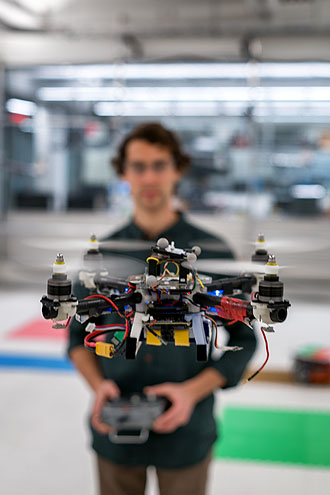Drone Home: New Robotics Lab Gives Researchers and Their ‘Bots Room to Roam
 By Sara Elizabeth Cody
By Sara Elizabeth Cody
As an animation technique, motion capture, has been prominently featured in a number of blockbuster films for more than a decade, bringing fictional characters, like Gollum from Lord of the Rings, to life. This same technology is allowing BU researchers study robotics and the relationship between man and machine in the new home of the Robotics Lab, located behind the Engineering Product Innovation Center (EPIC).
“The nicest thing about the facility is that we are now self-contained and everything is in one place,” says Professor Calin Belta (ME, SE), director of the BU Robotics Lab, who moved his team into the shared space last semester and has been joined by the research groups of Professor John Baillieul (ME, SE) and Assistant Professor Roberto Tron (ME, SE). “Normally these types of workshop spaces are hidden away in basements, but the fact that we have such a large facility that is out in the open makes a huge difference in terms of atmosphere. It makes for a more collaborative environment, which makes the students happier.”
In addition to making the space student-friendly, the Robotics Lab has also had a positive impact among faculty as well, noted Ballieul.
“Faculty have embraced the facility as a shared resource,” says Baillieul. “This has led to a renewed sense of collegiality among the ME robotics research groups.”
The Robotics Lab includes an experimental arena, a workshop, a student seating area and a conference room. The experimental arena resembles a cross between a hockey arena and BattleBots ring. It consists of a motion capture system containing more than 50 infrared cameras and several short-throw projectors that can create dynamic images on the floor. Reflective balls on the robots allow researchers to track their movements with infrared as the robots perform various tasks in the arena.
“Most of my research is centered on mobile robotics,” says Belta, who uses the experimental arena frequently. “We are using both ground and aerial robots to develop control strategies for unmanned aircraft and ground vehicles in unstructured environments, such as disaster areas.”
By projecting images onto the floor in the experimental arena, Belta’s research team runs disaster relief scenarios, where the goal is to send a robot into a disaster zone and have it find its way through collapsed buildings and debris. They want it to be able to build a map, identify areas of interest and locate survivors. Not only do they want the robot to be able to gather data about disaster zones, they also want it to be self-aware in terms of knowing when it has to return to recharge.
The BU Robotics Lab is also home to a workshop, where lab members design and construct robots, an open-concept student workspace, and a sound-proof, wireless conference room that makes it easy to work with colleagues off-campus. Numerous whiteboards pepper the lab, with scribbled notes from brainstorming sessions attesting to the collaboration that takes place there.
Future plans for the facility include recruiting other groups to work in the space, while continuing to add equipment. Given the dynamic, visual nature of the lab and its research, Belta anticipates incorporating more outreach initiatives within its scope as well, such as the Technology Innovation Scholarship Program (TISP), which sends undergraduate engineering students into middle- and high-school classrooms to inspire the next generation of engineers. The Robotics Lab supplies smaller-scale robots that can be packed up and transported to classrooms and TISP students use them to give fun, interactive presentations about engineering and to work with students on designing and creating their own engineering projects.
“We are funded primarily by the Department of Defense, but we have received support from the National Science Foundation as well, which has a strong focus on outreach initiatives,” says Belta. “Recently there has been a big push to study robot-human interaction and maintaining this balance of giving the robot autonomy to make decisions and allowing the human to step in as needed. Our new facility allows us to experiment with this interaction in real-time, which is invaluable.”